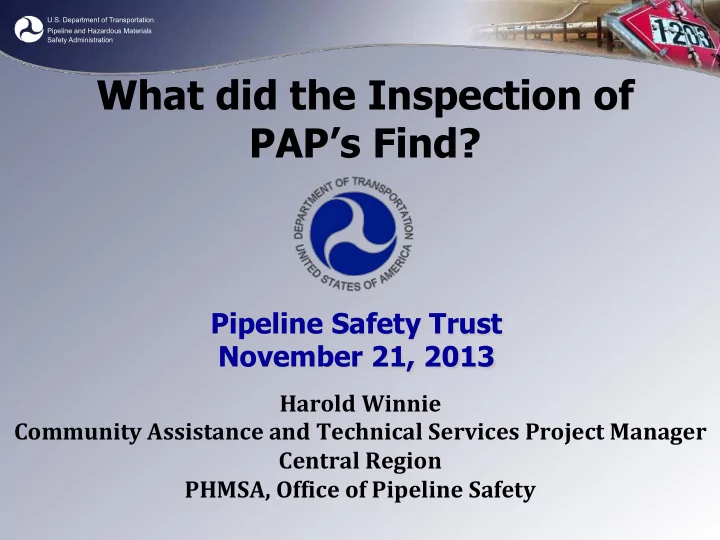

U.S. Department of Transportation Pipeline and Hazardous Materials Safety Administration What did the Inspection of PAP’s Find? Pipeline Safety Trust November 21, 2013 Harold ¡Winnie ¡ Community ¡Assistance ¡and ¡Technical ¡Services ¡Project ¡Manager ¡ Central ¡Region ¡ PHMSA, ¡Of@ice ¡of ¡Pipeline ¡Safety ¡
U.S. Department of Transportation Pipeline and Hazardous Materials Safety Administration PAP Inspection Updates • PAP ¡Inspection ¡timeline: ¡ – Federal ¡PAP ¡Inspections ¡completed ¡by ¡end ¡of ¡2012 ¡ – Interstate ¡agent ¡inspections ¡completed ¡by ¡end ¡of ¡ 2012 ¡ – States ¡are ¡also ¡incorporating ¡PAP ¡inspections ¡into ¡ their ¡normal ¡inspection ¡cycle ¡by ¡end ¡of ¡2013 ¡ • Finalized ¡documented ¡published ¡online: ¡ – PAP ¡Effectiveness ¡Inspection ¡Form ¡ ¡http://www.phmsa.dot.gov/pipeline/library/forms ¡ ¡ – PAP ¡Enforcement ¡Guidance ¡Document ¡ ¡http://www.phmsa.dot.gov/foia/e-‑reading-‑room ¡
U.S. Department of Transportation Pipeline and Hazardous Materials Safety Administration PAPEE Inspections Lead by PHMSA Completed Inspections: Total completed 258 NOA’s 88 Warning Letters 51 NOPV’s 15 Compliance Orders 7 Letter’s of Concern 2
U.S. Department of Transportation Pipeline and Hazardous Materials Safety Administration PAP Inspection Process ¡ ¡ – Section ¡One ¡-‑-‑ ¡ ¡ ¡ ¡ ¡Have ¡a ¡Complete ¡Plan ¡ – Section ¡Two ¡-‑-‑ ¡ ¡ ¡ ¡ ¡Implement ¡the ¡Plan ¡ – Section ¡Three ¡-‑-‑ ¡Annual ¡Implementation ¡ ¡ ¡ ¡ ¡ ¡Review ¡ ¡ – Section ¡Four ¡-‑-‑ ¡ ¡ ¡Effectiveness ¡Evaluation ¡ ¡ ¡ ¡ ¡ ¡Process ¡ ¡
U.S. Department of Transportation Pipeline and Hazardous Materials Safety Administration Public ¡Awareness ¡Inspections ¡ Section ¡One ¡ 36.84% 40.00% 35.00% 29.63% 30.00% 25.00% 18.52% 16.30% 20.00% 14.81% 15.00% 10.45% 10.00% 5.00% 0.00% 1.01 1.02 1.03 1.04 1.05 1.06
U.S. Department of Transportation Pipeline and Hazardous Materials Safety Administration Section One 1.04 – Stakeholder Audience Identification • Missed Audiences/ Parts of Audiences • Didn’t include other information in audience ID (IMP) to Establish distance either side of pipeline 1.06 – Written Evaluation Plan • Written plan to conduct and evaluate • Correct Frequencies • Statistical Sample Size, Confidence Level and M.O.E., by Stakeholder Audience ¡
U.S. Department of Transportation Pipeline and Hazardous Materials Safety Administration Public ¡Awareness ¡Inspections ¡ ¡ Section ¡Two ¡ 39.26% 40.00% 35.00% 28.89% 30.00% 23.70% 25.00% 19.26% 17.04% 20.00% 11.11% 15.00% 10.00% 5.00% 0.00% 2.01 2.02 2.03 2.04 2.05 2.06
U.S. Department of Transportation Pipeline and Hazardous Materials Safety Administration Section ¡Two ¡ 2.01 - English and Other Languages Process, Frequency, Source 2.02 - Message Type and Content Message Mapping (1162 / PAP/ Brochures) 2.06 - Maintaining Liaison with Emergency Responders ERP Available, Sharing Capabilities Non-Attendees (Closing the Loop) ¡
U.S. Department of Transportation Pipeline and Hazardous Materials Safety Administration Implementation ¡ Messages ¡ Collaborative ? ? ? Operator Specific Educating Stakeholders
U.S. Department of Transportation Pipeline and Hazardous Materials Safety Administration Public ¡Awareness ¡Inspections ¡ Section ¡Three ¡ ¡ 31.11% 35.00% 30.00% 20.90% 25.00% 20.00% 15.00% 9.63% 10.00% 5.00% 0.00% 3.01 3.02 3.03
U.S. Department of Transportation Pipeline and Hazardous Materials Safety Administration Section ¡Three ¡ 3.01 - Measuring Program Implementation • Documents that Verify Annual Review • Guide a Consistent Process. 3.03 - Program Changes and Improvements (Document what was reviewed, Considered, Decisions, implementation, by whom and by Date Due)
U.S. Department of Transportation Pipeline and Hazardous Materials Safety Administration Evaluations ¡(Annual ¡Audits) ¡ Some operators: • Documented meetings, dates, participants, agenda • Meeting with cross-functional review teams (prevent silos) • Defined/monitored metrics • Combined annual audit & effectiveness evaluation in year 4 • Linked timing and review with other programs: • Integrity management • Emergency response ¡ ¡
U.S. Department of Transportation Pipeline and Hazardous Materials Safety Administration Program ¡Changes ¡and ¡Improvements ¡ • Changes/documented tracked? • Implemented changes during next year • Verified adequate resources were available • Updated written plan • Obtained current management support • Reviewed supplemental enhancements • Changes to print material ¡
U.S. Department of Transportation Pipeline and Hazardous Materials Safety Administration Section Four 36.30% 40.00% 34.81% 34.59% 32.59% 35.00% 30.37% 28.03% 30.00% 25.00% 20.90% 20.00% 15.00% 10.00% 5.00% 0.00% 4.01 4.02 4.03 4.04 4.05 4.06 4.07
U.S. Department of Transportation Pipeline and Hazardous Materials Safety Administration Section ¡Four ¡ 4.01 - Evaluating Program Effectiveness 4 years from Implementation, Sample Size, MOE, Confidence Level 4.02 - Measure Outreach Actual Number by Stakeholder Audience 4.03 - Percentage of Stakeholders Reached 4.04 - Understandability of Message Content 4.05 - Desired Stakeholder Behavior 4.06 - Bottom Line Results Considered other Bottom Line Measures 4.07 - Program Changes Document Changes - ¡
U.S. Department of Transportation Pipeline and Hazardous Materials Safety Administration Section Four How effective is the operator’s public awareness program? • Collecting data is not the only component to completing an effectiveness evaluation. • Operator effectiveness evaluations should: • Identify program metrics • Describe evaluation methodology • Summarize findings or conclusions • Identify changes in written plan and/or implementation ¡
U.S. Department of Transportation Pipeline and Hazardous Materials Safety Administration What Did PHMSA Find? • Most Operators Have Developed and Implemented Public Awareness Programs • Room to Improve the Programs • Process/methodology improvements are needed with annual audits/effectiveness evaluations • Challenge is Motivating Stakeholders to Stop, Listen, and Change • Balancing information overload with specific messages
Recommend
More recommend